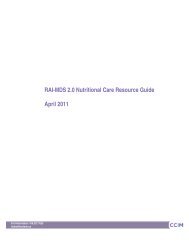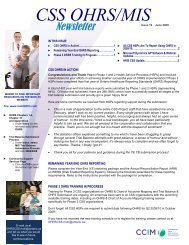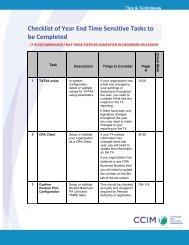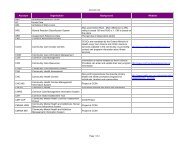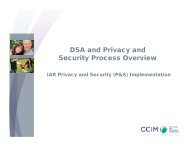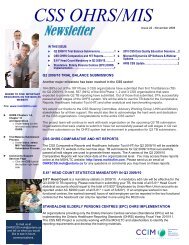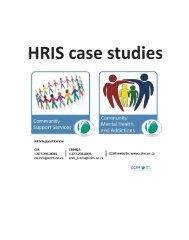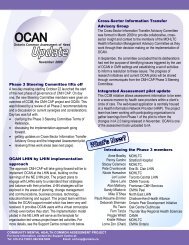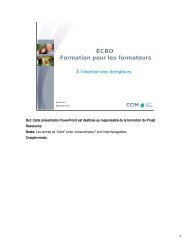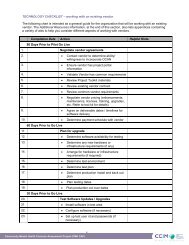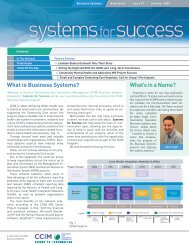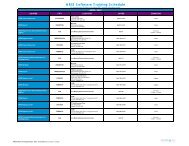Data Submission and Technical Specifications (PDF - CCIM
Data Submission and Technical Specifications (PDF - CCIM
Data Submission and Technical Specifications (PDF - CCIM
Create successful ePaper yourself
Turn your PDF publications into a flip-book with our unique Google optimized e-Paper software.
Community Care Information Management (<strong>CCIM</strong>)<br />
IAR <strong>Data</strong> <strong>Submission</strong><br />
`<br />
2.6 Testing Process<br />
`<br />
IAR’s policy is to only accept submissions that conform to specifications provided to vendors <strong>and</strong><br />
organizations. IAR will not accept live data until organizations’ vendors have successfully<br />
completed the st<strong>and</strong>ard testing process. A successful test is a submission that conforms to the<br />
specified schemas.<br />
The primary objectives of the st<strong>and</strong>ard testing process are to validate:<br />
• XML structure to ensure that it adheres to the specified XSD<br />
• All m<strong>and</strong>atory fields/values to ensure that they are populated<br />
• All expected values to ensure that they validate against expected value lists<br />
• Network Connectivity / ability to establish access to IAR environment<br />
IAR provides an Implementation Validation toolkit that includes test scenarios. Using the<br />
Implementation Validation toolkit, testing will be conducted in 2 phases (vendor testing <strong>and</strong> User<br />
Acceptance Testing) for each organization that uses a vendor external to the organization. If an<br />
organization uses an in-house vendor system, the vendor will be considered part of the<br />
organization <strong>and</strong> testing will be conducted in a single phase.<br />
Organizations using automated submission method:<br />
1. Once the interface is completed <strong>and</strong> tested by the vendor, vendors will generate <strong>and</strong> submit<br />
XML test file(s) to be validated by the IAR project team.<br />
2. Once the web service client is completed by the vendor <strong>and</strong> the XML structure (XSD) is<br />
validated, vendors will transmit test submissions in the IAR test environment using the web<br />
service client.<br />
3. Once the solution is delivered to the organization, a User Acceptance Testing (UAT) phase<br />
will be conducted to ensure that business requirements are met <strong>and</strong> assessment data can be<br />
sent to the IAR data repository.<br />
Organizations using manual submission method:<br />
1. Once the interface is completed <strong>and</strong> tested by the vendor, vendors will generate <strong>and</strong> submit<br />
XML test file(s) to be validated by the IAR project team<br />
2. Once the solution is delivered to the organization, a User Acceptance Testing (UAT) phase<br />
will be conducted to ensure that business requirements are met <strong>and</strong> assessment data can be<br />
sent to the IAR data repository.<br />
2.7 IAR PHI Validation Tables<br />
<strong>CCIM</strong> PHI<br />
<strong>Data</strong> Element Type Status<br />
Client ID (e.g. Chart Number) xsd:string M<strong>and</strong>atory<br />
First Name xsd:string M<strong>and</strong>atory<br />
Last Name xsd:string M<strong>and</strong>atory<br />
Phone Number xsd:string Optional<br />
Health Card Number xsd:string Optional<br />
Country of Residence xsd:string M<strong>and</strong>atory<br />
Province/Territory Issuing Health Card Number xsd:string Optional<br />
Gender xsd:string Optional<br />
Date of Birth(DOB) xsd:date Optional<br />
Estimated Birthday xsd:string Optional (“Yes” is estimated<br />
“No” otherwise<br />
16



